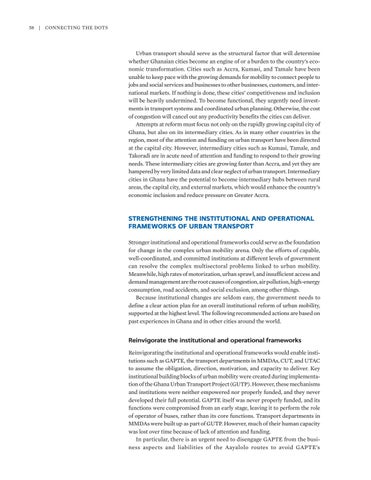58 | Connecting the Dots
Urban transport should serve as the structural factor that will determine whether Ghanaian cities become an engine of or a burden to the country’s economic transformation. Cities such as Accra, Kumasi, and Tamale have been unable to keep pace with the growing demands for mobility to connect people to jobs and social services and businesses to other businesses, customers, and international markets. If nothing is done, these cities’ competitiveness and inclusion will be heavily undermined. To become functional, they urgently need investments in transport systems and coordinated urban planning. Otherwise, the cost of congestion will cancel out any productivity benefits the cities can deliver. Attempts at reform must focus not only on the rapidly growing capital city of Ghana, but also on its intermediary cities. As in many other countries in the region, most of the attention and funding on urban transport have been directed at the capital city. However, intermediary cities such as Kumasi, Tamale, and Takoradi are in acute need of attention and funding to respond to their growing needs. These intermediary cities are growing faster than Accra, and yet they are hampered by very limited data and clear neglect of urban transport. Intermediary cities in Ghana have the potential to become intermediary hubs between rural areas, the capital city, and external markets, which would enhance the country’s economic inclusion and reduce pressure on Greater Accra.
STRENGTHENING THE INSTITUTIONAL AND OPERATIONAL FRAMEWORKS OF URBAN TRANSPORT Stronger institutional and operational frameworks could serve as the foundation for change in the complex urban mobility arena. Only the efforts of capable, well-coordinated, and committed institutions at different levels of government can resolve the complex multisectoral problems linked to urban mobility. Meanwhile, high rates of motorization, urban sprawl, and insufficient access and demand management are the root causes of congestion, air pollution, high-energy consumption, road accidents, and social exclusion, among other things. Because institutional changes are seldom easy, the government needs to define a clear action plan for an overall institutional reform of urban mobility, supported at the highest level. The following recommended actions are based on past experiences in Ghana and in other cities around the world.
Reinvigorate the institutional and operational frameworks Reinvigorating the institutional and operational frameworks would enable institutions such as GAPTE, the transport departments in MMDAs, CUT, and UTAC to assume the obligation, direction, motivation, and capacity to deliver. Key institutional building blocks of urban mobility were created during implementation of the Ghana Urban Transport Project (GUTP). However, these mechanisms and institutions were neither empowered nor properly funded, and they never developed their full potential. GAPTE itself was never properly funded, and its functions were compromised from an early stage, leaving it to perform the role of operator of buses, rather than its core functions. Transport departments in MMDAs were built up as part of GUTP. However, much of their human capacity was lost over time because of lack of attention and funding. In particular, there is an urgent need to disengage GAPTE from the business aspects and liabilities of the Aayalolo routes to avoid GAPTE’s
